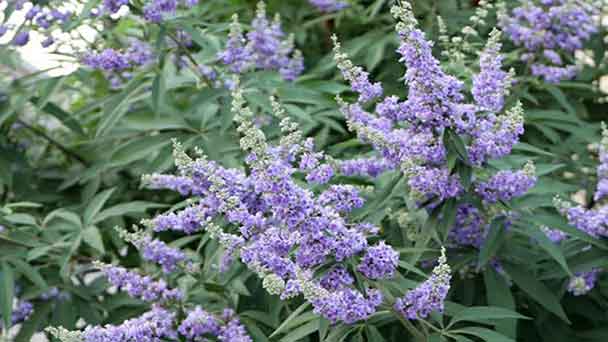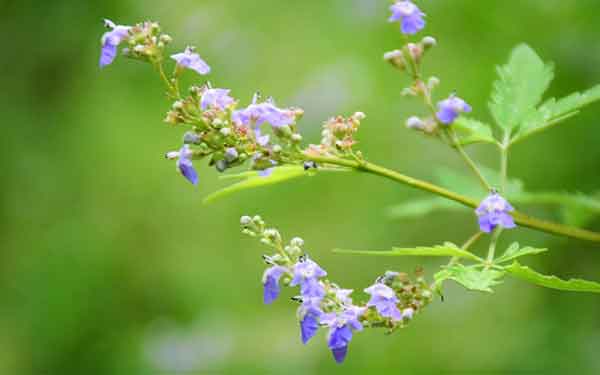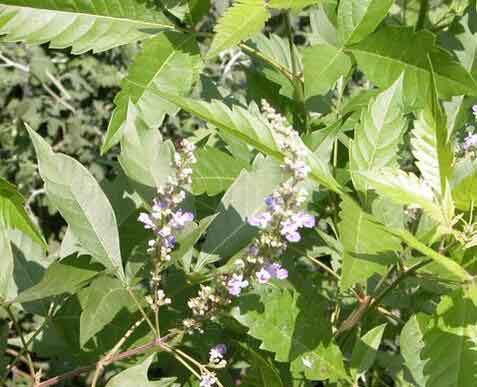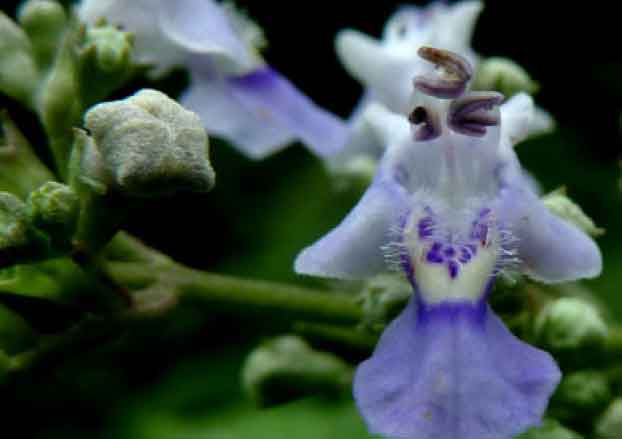Vitex: Grow & Care for Vitex agnus-castus
Written by Iris
Sep 03 2021

Vitex (Vitex agnus-castus) grows well in southern Arizona, despite its origins in southern Europe and the Mediterranean. Much like a shrub and naturally multi-trunk, Vitex (Vitex agnus-castus) can be trained to become a small tree, eventually reaching a mature size of 20 feet tall and 20 feet long. The leaves of Vitex (Vitex agnus-castus) are grayish green above and silver below. Long, narrow spikes of purple flowers appear in late spring and early summer. The most common color is purple.

Seeds have a good success rate, but the weakest Vitex tree seedlings should be alienated and only the strongest seedlings go on to grow into a tree. Make sure the soil remains slightly wet until the plant is established.
Propagation from stem cuttings using Vitex trees is also a simple process. You'll need to find a 4 - to 6-inch cork cut from your Vitex trees. Cork cuttings are those that are neither new nor old. To determine if you have identified cork correctly, simply bend the stem and see how it responds to pressure.
The new stem bends easily, but the old stem does not. Cork stems should be broken when bent. These are the stems needed for reproduction. Remove the lower leaves from the stem, dip the cut ends in rooting hormones, and place them in a soilless pot culture medium. Tuck it in, then cover it with a plastic bag or container to simulate greenhouse conditions. Cut in bright indirect light to keep the potting mixture moist.
The roots should develop in about 4 to 6 weeks, at which point you can remove the plastic bag or container and transplant the cut into a larger pot. Let these new plants grow over the next few months and plant your new Vitex trees outside in the spring.

Next, consider the size and shape you want Vitex trees to have for the next growing season. Generally, when pruning is complete, the bush will be rounded and the branches will grow outward from the base, forming a balanced frame. Pruning should be done over a pair of buds. Dormant buds can be difficult to identify at first; They look like small scales on smooth branches. Those buds will awaken next season, and new growth will produce giant flowers at the tip of August.
Thysanoptera, also known as thrips will attack the Vitex. These little pests suck on the stems. Use a systemic insecticide to kill them. Or spray them with Neem oil. B.T.W. not all thrips are bad some are actually beneficial. Read this post on gardening know-how.
Vitex 'Abbeville Blue' grows 6 feet tall with a similar spread. It has deep blue flowers on 12- to 18-inch spikes.
Vitex 'Alba' has white flowers. It is a large plant, growing to 15 feet with a 20-foot spread.
Vitex 'Shoal Creek' is a 15-foot-tall plant with purple-blue flowers and leaves that have good resistance to fungal spots.
Vitex 'Blue Puffball' is a great small shrub, growing only 3 feet tall with delicate blue flowers.
'Rosa Ann' is a 15-foot plant with heavily scented pink flowers.
Smaller cultivars for potting include Blue Diddley (grows to 6 feet) and Blue Puffball (grows to 3 feet).
How to Choose and Prepare a Planting SiteHow to Grow Vitex (Vitex agnus-castus)Steps for Vitex (Vitex agnus-castus) Propagation with SeedsSteps for Vitex (Vitex agnus-castus) Propagation with Stem CuttingsHow to Care for Vitex (Vitex agnus-castus)LightSoilWaterTemperature and HumidityFertilizerPruningPests and DiseasesVarieties of Vitex (Vitex agnus-castus)
How to Choose and Prepare a Planting Site
Vitex (Vitex agnus-castus) is best planted in full sun. Vitex will tolerate some shadows but will do better in full sunlight. Water regularly for the first 2-3 years after initial planting. Once established, you can reduce watering to about 1-2 times a week during midsummer. After season 5, you can cut it down to about twice a month. Vitex (Vitex Agnus-Castus) is planted in rocky landscapes because they can withstand reflected heat from rocky floor coverings. Use Vitex (Vitex Agnus-Castus) with other Xeriscape plants, but do not plant them in the shade of this tree.
How to Grow Vitex (Vitex agnus-castus)
Steps for Vitex (Vitex agnus-castus) Propagation with Seeds
Vitex (Vitex Agnus-Castus) readily self-propagates by reseeding. Withered flowers develop into berries containing seeds, and new Vitex (Vitex agnus-castus) grows where the berries fall. If you are happy to randomly grow more Vitex trees around your garden, then by all means leave the flowers on the trees to do your own business. Some people find Vitex (Vitex agnus-castus) can be reseeded so well that it becomes invasive in their gardens. If you want to prevent self-planting, you should pick the flowers as soon as they start. Deadheading also helps encourage longer flowering, so the benefit of this effort is twofold.Steps for Vitex (Vitex agnus-castus) Propagation with Stem Cuttings
For more intentional propagation of Vitex trees, you can grow plants from seeds or stem cuttings. Plant your seeds outdoors directly after the last frost or indoors four to six weeks before the last expected frost to get a head start.Seeds have a good success rate, but the weakest Vitex tree seedlings should be alienated and only the strongest seedlings go on to grow into a tree. Make sure the soil remains slightly wet until the plant is established.
Propagation from stem cuttings using Vitex trees is also a simple process. You'll need to find a 4 - to 6-inch cork cut from your Vitex trees. Cork cuttings are those that are neither new nor old. To determine if you have identified cork correctly, simply bend the stem and see how it responds to pressure.
The new stem bends easily, but the old stem does not. Cork stems should be broken when bent. These are the stems needed for reproduction. Remove the lower leaves from the stem, dip the cut ends in rooting hormones, and place them in a soilless pot culture medium. Tuck it in, then cover it with a plastic bag or container to simulate greenhouse conditions. Cut in bright indirect light to keep the potting mixture moist.
The roots should develop in about 4 to 6 weeks, at which point you can remove the plastic bag or container and transplant the cut into a larger pot. Let these new plants grow over the next few months and plant your new Vitex trees outside in the spring.

How to Care for Vitex (Vitex agnus-castus)
Light
The vitex tree enjoys full sun conditions but can also grow well in partial shade. Aim to provide the plant with at least 6 hours of sun a day to ensure prolific blooming. If you don’t have a full-sun position available for the vitex tree, sit it in a spot where it will receive morning sun and afternoon shade. This will help to offer the plant some relief during the hottest portion of the day.Soil
Although Vitex plants can tolerate the sandy soils typical of coastal areas, all Vitex plants grow best in soils that are well-drained and rich in organic matter. Vitex plants are also salt-tolerant and can cope well with wind. Vitex plants prefer average water and grow best when watered regularly. However, because they are native to relatively dry areas of Africa and southern Europe, Vitex trees can also tolerate dry spells and can survive droughts unscathed.Water
During the summer, avoid watering your chaste tree until the soil has either dried out or is only slightly damp. Overwatering will lead to root rot, so the best approach is to give the plant a thorough soaking and then allow it to dry out rather than watering it daily. If your plant starts to drop leaves, it needs more water. During cool months the plant needs little water.Temperature and Humidity
Vitex agnus-castus may be grown in Zones 6 to 9; it is technically hardy down to about -9 degrees Fahrenheit. But in zones 6, it often is grown more as a perennial plant rather than a shrub, since it may die back to the ground each winter, regrowing in spring. It does equally well in the high humidity of the Southeast U.S. as in the arid climate of the Southwest.
Fertilizer
Using 2 to 3 inches of organic mulch a year, such as wood chips or grass chips, can help vitex plants grow well, helping to hold water in the soil and stop weeds. The mulch should be renewed each spring or whenever it begins to decompose. Although Vitex plants are relatively carefree plants, you can help your Vitex trees grow faster by applying a light amount of balanced fertilizer (such as the 10-10-10 formula) each spring and early summer.Pruning
Start by removing any dead, broken or bearded branches from Vitex trees. Weak growth will not support a flower or fill the mainframe, so it is best to direct the plant's energy to stronger branches. If there are any old branches in the area where new growth is beginning to fill the bush, remove them from the ground in favor of younger growth.Next, consider the size and shape you want Vitex trees to have for the next growing season. Generally, when pruning is complete, the bush will be rounded and the branches will grow outward from the base, forming a balanced frame. Pruning should be done over a pair of buds. Dormant buds can be difficult to identify at first; They look like small scales on smooth branches. Those buds will awaken next season, and new growth will produce giant flowers at the tip of August.
Pests and Diseases
The Vitex tree is not susceptible to insects and or diseases. There have been known cases of powdery mildew with this tree. Usually caused by overwatering or too much rainfall in the area. Treat it with fungus control if you find a white powdery substance on the foliage. Click on the following Insects and diseases on plants for what it looks like on other plants.Thysanoptera, also known as thrips will attack the Vitex. These little pests suck on the stems. Use a systemic insecticide to kill them. Or spray them with Neem oil. B.T.W. not all thrips are bad some are actually beneficial. Read this post on gardening know-how.

Varieties of Vitex (Vitex agnus-castus)
Several cultivars of vitex are widely sold:Vitex 'Abbeville Blue' grows 6 feet tall with a similar spread. It has deep blue flowers on 12- to 18-inch spikes.
Vitex 'Alba' has white flowers. It is a large plant, growing to 15 feet with a 20-foot spread.
Vitex 'Shoal Creek' is a 15-foot-tall plant with purple-blue flowers and leaves that have good resistance to fungal spots.
Vitex 'Blue Puffball' is a great small shrub, growing only 3 feet tall with delicate blue flowers.
'Rosa Ann' is a 15-foot plant with heavily scented pink flowers.
Smaller cultivars for potting include Blue Diddley (grows to 6 feet) and Blue Puffball (grows to 3 feet).
Latest Updated
- Benefits of Bugleweed - 7 Science-backed Health Benefits
- Bugleweed Dangers & Side Effects - Is It Poisonous?
- How to Plant Evergreen Trees - What You Should Know
- When to Plant Evergreens - Grow Guide for Evergreen Trees
- 12 Wonderful Evergreen Shrubs for Your Garden
- 12 Popular Evergreen Plants with Pictures for Beginners
- When And How To Prune A Lilac Bush Like a Pro
- How to Grow & Care for Lilac Vine (Hardenbergia Violacea)
- Japanese Lilac Tree (Syringa Reticulata) Care & Propagation Guide
- Shumard Oak Pros and Cons - What to Know
Popular Articles
- Winter maintenance of Antirrhinum Majus
- How to Grow Terminalia Mantaly Tree
- How to Grow and Care for Crossostephium Chinense
- How to grow Antirrhinum Majus in spring
- Peristeria Elata (Dove Orchid) Profile: Info & Care Guide
- Underwatered Snake Plant (Sansevieria Trifasciata) - Signs And How To Fix
- How to Care for Brazilian Jasmine Plant (Mandevilla Sanderi)
- How to Grow & Care for Graptopetalum Purple Delight in Summer
- Rosa Chinensis (China Rose): Plant Growing & Care Tips
- How to Care for Baby Sun Rose (Aptenia Cordifolia)